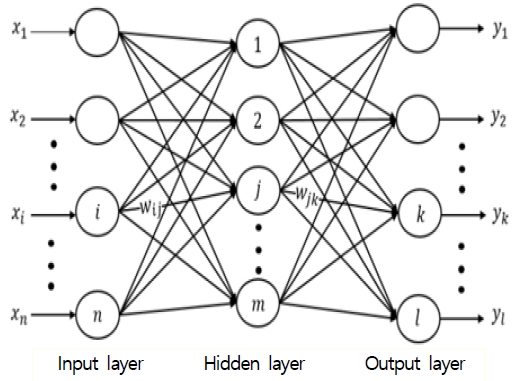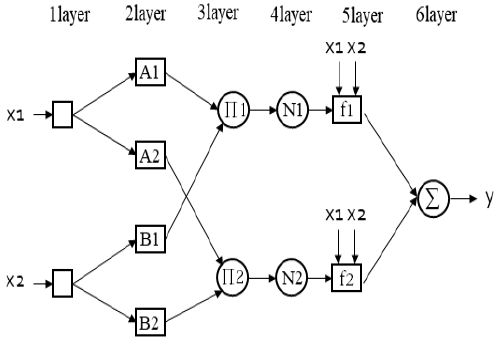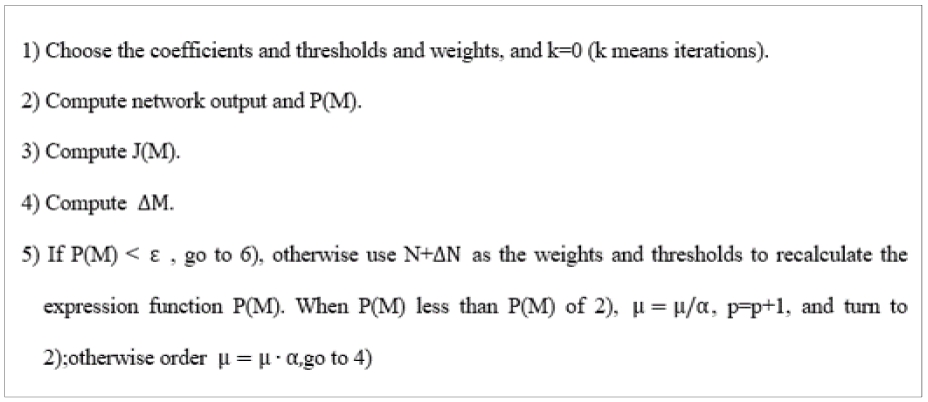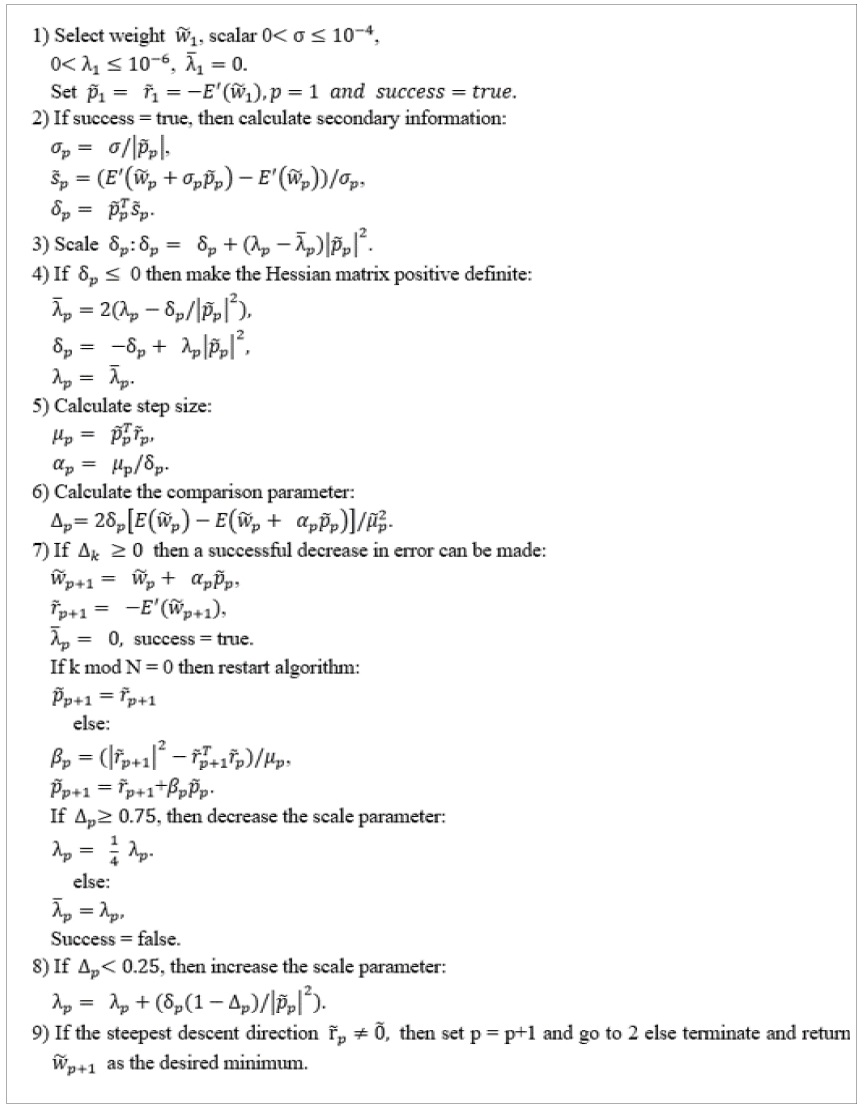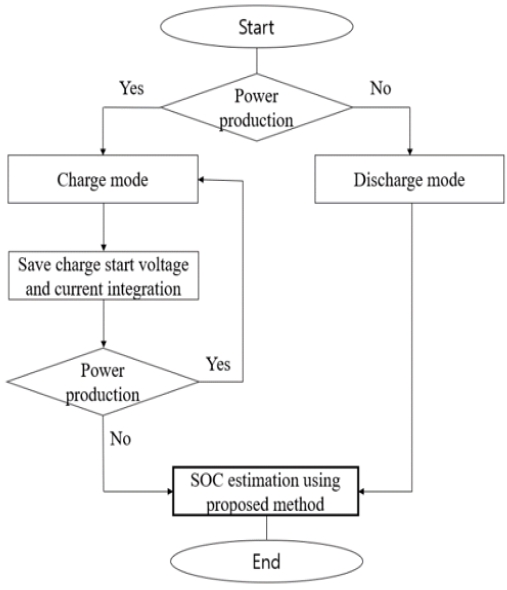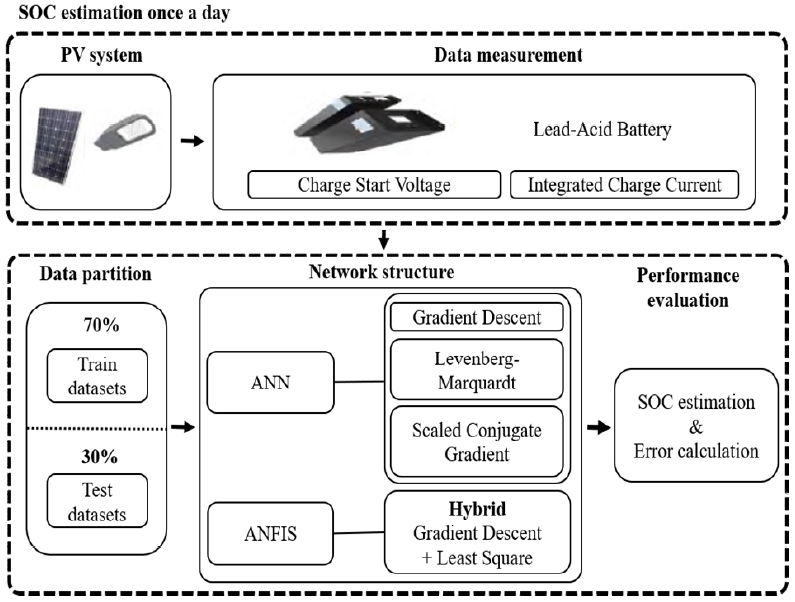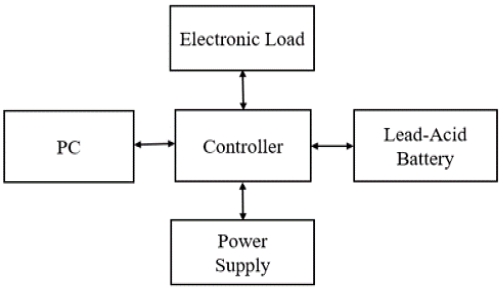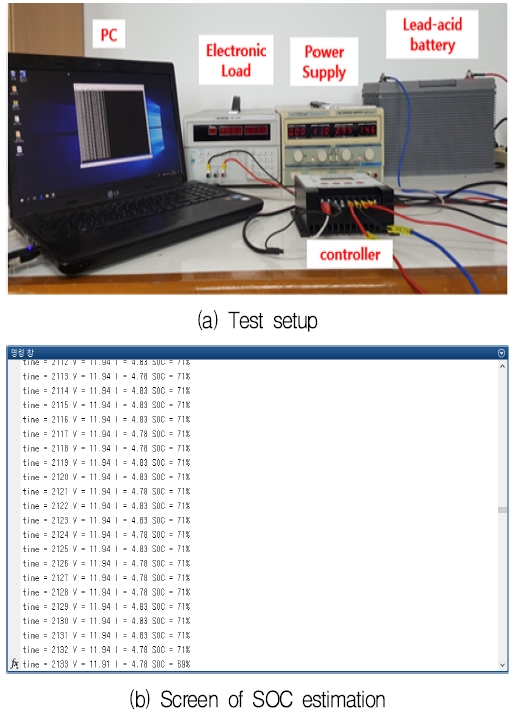
Battery State-of-Charge Estimation Using ANN and ANFIS for Photovoltaic System
Abstract
Estimating the state of charge (SOC) of a battery is essential for increasing the stability and reliability of a photovoltaic system. In this study, battery SOC estimation methods were proposed using artificial neural networks (ANNs) with gradient descent (GD), Levenberg–Marquardt (LM), and scaled conjugate gradient (SCG), and an adaptive neuro-fuzzy inference system (ANFIS). The charge start voltage and the integrated charge current were used as input data and the SOC was used as output data. Four models (ANN-GD, ANN-LM, ANN-SCG, and ANFIS) were implemented for battery SOC estimation and compared using MATLAB. The experimental results revealed that battery SOC estimation using the ANFIS model had both the highest accuracy and highest convergence speed.
초록
태양광 시스템의 안정성과 신뢰성 향상을 위해서는 배터리의 잔존량 (State of Charge, SOC)을 정확하게 추정하여야 한다. 본 연구에서는 gradient descent, Levenberg-Marquardt 및 scaled conjugate gradient 학습방법을 사용한 인공 신경회로망 (Artificial Neural Networks, ANN)과 적응형 뉴로-퍼지 추론 시스템 (Adaptive Neuro-Fuzzy Inference System, ANFIS)을 사용한 SOC 추정방법을 제안한다. 입력으로는 충전 시작 전압 및 적류적산법을 통해 구한 충전 전류를 사용하여 추정된 SOC를 출력한다. 4개의 모델 (ANN-GD, ANN-LM, ANN-SCG, 및 ANFIS)을 사용하여 SOC 추정 방법을 구현하였고 실험을 통해 MATLAB을 사용하여 4개의 모델의 성능을 비교 분석하였다. 실험 결과로부터 ANFIS 모델을 사용한 배터리의 SOC 추정이 가장 정확도가 높았으며 빠른 속도로 수렴함을 확인하였다.
Keywords:
SOC, lead-acid battery, ANN, levenberg–marquardt, scaled conjugate gradient, ANFISⅠ. Introduction
The interest in renewable energy industries, such as solar power generation and wind power generation, is increasing worldwide. This is due to the increasing severity of global environmental problems, such as the depletion of petroleum resources and global warming. The number of facilities that charge batteries using solar energy is also increasing. Among them, solar streetlights using photovoltaic (PV) power generation are ubiquitous, and their demand is continuing to increase [1].
A solar streetlight system is a standalone system. A standalone system has advantages, such as not requiring electric wire construction and reducing CO2 because it is operated by PV power generation. However, the system operation time is dependent on the battery. A day with less than 0.1 h of sufficient sunlight for power generation is considered a sunless day, and solar streetlights are guaranteed to function for at least three sunless day [2]. In other words, it is possible to operate the system stably by calculating the battery state of charge (SOC) so that the light-emitting diode (LED) lamp can be lit for three days by the power stored in the battery even when power generation is not possible due to the weather. The equation for obtaining the number of sunless days is as follows:
| (1) |
where n is number of sunless day, SOC is the state of charge, V is the nominal voltage, W is the power consumption, a is the loss factor of battery.
The SOC is determined according to the amount of charge from the solar cell module and the amount of power consumed by the LED lamp. Therefore, (1) can be used to determine whether at least three sunless days can always be guaranteed to control the LED lamp power consumption. This can be achieved by accurately estimating the battery SOC to be can actively adjust the available day in sunless day. Therefore, it is necessary not only to depend on the initial battery design capacity, but also to predict the present battery SOC more accurately and control the power consumption of the LED lamp to guarantee with greater certainty the number of days of idle time.
Current methods of estimating SOC are as follows [3]. The first is the Kalman filter method, which can estimate SOC with high accuracy. However, this method has high computational complexity and is difficult to use [4]. The second method is the current integration (CI) method, in which SOC is determined by the previous capacity and the capacity charged or discharged. This method integrates the charge and discharge currents and subtracts the initial SOC to estimate the current SOC. However, this method increases the error over time due to the accumulation of sensor errors. Therefore, it must be regularly calibrated to estimate the accurate SOC [5]. Finally, the open circuit voltage (OCV) method estimates the battery SOC by measuring the OCV. However, this method cannot be easily applied to a system operating in real time because it performs measurement without connecting the load [6]. Lupi et al. studied SOC estimation using FUDS and US06 drive cycle for electric vehicles [7].
In recent years, neural network (NN) models have been used in various fields, such as pattern recognition and classification [8]. The advantages of using a NN model for fault diagnosis include the fact that the system can be efficiently identified and the system parameters can be adjusted by adaptive learning and parallel processing [9]-[13].
This paper proposes a lead–acid battery SOC estimation method using an artificial NN (ANN) and an adaptive neuro-fuzzy inference system (ANFIS). The ANN model uses three different training methods (gradient descent (GD), Levenberg–Marquardt (LM), and scaled conjugate gradient (SCG) under the same network configuration. In this study, the performance of each network is compared.
Ⅱ. Neural-network structure
2.1 Artificial neural network
The basic structure of an ANN is presented in Fig. 1. An ANN consists of an input layer, hidden layer, and output layer. Each layer is composed of nodes and weights between the nodes. An ANN computes the correct output values for given input values. It also predicts the best generalized output for new input values even if the input values are not used for learning.
2.2 Adaptive neuro-fuzzy inference system
In the ANFIS model [14], the Sugeno fuzzy model is a systematic method of generating fuzzy rules from the input data and output datasets. Furthermore, it uses a hybrid learning method that is a mixture of the least squares estimator and GD method. The hybrid learning method has the advantage of being able to converge quickly [15].
As illustrated in Fig. 2, ANFIS is divided into six layers: the input layer, fuzzification layer, rule layer, normalization layer, defuzzification layer, and summation neuron layer. xn represents the input values, An represents the sets of fuzzy, fn represents the output function, and y represents the output value as follows:
| (2) |
where k0, k1, and k2 are the sets of arguments of set in rule i.
Ⅲ. Optimization methods
3.1 Gradient descent method
The GD method adjusts the weights to minimize the error between the target and the model output value [16], and is expressed as follows:
| (3) |
where ek(p) is the error and is the activation function. δk(p) updates the weights(wjk) as illustrated in (4) and (5):
| (4) |
| (5) |
where Δwjk(p) is the weight variation between the j-th hidden node and the k-th output node, η and p are the learning rate and epoch, respectively.
Similarly, the weight of the next node is as follows:
| (6) |
| (7) |
| (8) |
3.2 Levenberg-Marquardt method
The LM approach is a modification of the Newton method [17][18]. Using this approach, the Hessian matrix does not need to be calculated; therefore, it has fewer iterations and a fast convergence speed for secondary orders. M is the set of thresholds and weights of each layer, as illustrated in (9), and P(M) is presented in (10).
| (9) |
| (10) |
where E(M) express ei(M), I is the number of patterns, J(M) is the Jacobian matrix as in (11), and S(M) is the error function as in (12).
| (11) |
| (12) |
| (13) |
where ΔM is the adjustment quantity of M, and adjusting M represents adjusting the weights and bias, μ > 0 as constant.
This algorithm increases μ if the training fails and decreases μ if the training is successful. The algorithm steps are as follows:
3.3 Scaled conjugate gradient method
The SCG method is used for large problems. This method uses curvature in the NN without the line search process. Therefore, the amount of calculation of the gradient vector is reduced. The SCG method is as follows [19]:
Ⅳ. Proposed SOC estimation methods
The battery SOC estimation methods using ANN or ANFIS are proposed in this work. The concept of the SOC estimation method proposed is shown in Fig. 3. When the power production of the PV system by the solar panel is performed, it stores the charge start voltage together with the charge mode and starts to integrate the current. However, when power production is not performed, SOC estimation is performed by the proposed method together with the discharge mode.
To perform battery SOC estimation using the proposed methods, the charge start voltage (Vc) and the integrated charge current (Ic) are used as input parameters in these models. The reason for using these three parameters as training data of the NNs is that they have an important relation to lead–acid battery SOC. The reference SOC is obtained by (14) as follows:
| (14) |
where Id is the integral discharge current until the full discharge voltage, and CN is the nominal capacity of the battery.
In this study, there are four SOC estimation models using NNs for the PV system, and their performance is compared using the mean squared error (MSE) and root MSE (RMSE). The scheme of battery SOC estimation methods using ANN or ANFIS is illustrated in Fig. 4. Based on the collected data, SOC estimation models were constructed with an ANN using GD, LM, SCG, and ANFIS using Hybrid. Then, the performance of the SOC estimation models generated using untrained data was compared.
Ⅴ. Experiment results
5.1 Data acquisition environment
The experimental environment was designed to obtain real data required for battery SOC estimation for PV systems, as displayed in Fig. 5. In the experiment, 28 datasets were used. The datasets were divided into 22 datasets and six datasets as training data and test data, respectively.
The experimental environment consisted of a lead–acid battery, an electronic load, a power supply, a battery controller, and a PC. The battery controller prevented overcharging and overdischarging of the battery. In addition, the battery controller connected in series to the PC, and the data acquired by the battery controller were sent to the PC in real time. The power supply and electronic load were used to charge and discharge the battery. Table 1 presents a detailed specification of the experimental equipment.
5.2 Configuration of ANN and ANFIS
The NN model used in the system was constructed using MATLAB. The ANN model was composed of an input layer, hidden layer, and output layer, and used the 2-30-1 NN. The η was 0.01. The structure of the NN was selected by trial and error. The hyperbolic tangent sigmoid function was used for the hidden layer, and the linear transfer function was used for the output layer. The initial weights were random. The MSE was used as the cost function and is as follows:
| (15) |
where n is the number of training datasets, and dk represents the k-th desired values, and Ok represents the k-th output values of the ANN.
The configuration of the ANFIS model was that input nodes were 2, the output node was 1, membership functions were Gaussian 2, and the number of rule neurons was 49. Training was performed until the RMSE reached the error tolerance. The RMSE is presented in (16):
| (16) |
where n is the number of training datasets, yd(i)and y(i) are the desired output and the real output, respectively.
5.3 Comparison of SOC estimation models
The experiment was conducted using MATLAB, and the computer specifications were as follows: the central processing unit was Intel Core i7-3770 and the random-access memory was 8 GB. Three ANN models and one ANFIS model were implemented for the SOC estimation experiment.
The accuracy of the ANN-GD model was 98.74%, which was the second-best result; however, the learning time to the desired target was 10,432 epochs, which was considerably longer than that of other models. The accuracy of the ANN-LM model was 97.83%, which was the lowest of the three models. The accuracy of the ANN-SCG model was 98.7%, which was the third-best accuracy. Finally, the accuracy of the ANFIS model was 98.8%, which was superior among the four models, and the learning speed had the best performance with 81 epochs. An SOC estimation graph for six untrained data among the 28 collected data is presented in Fig. 6, and performance comparison is summarized in Table 2.
The experimental results indicate that the ANFIS model had the best performance among the four SOC estimation models for the PV system. To test the ANFIS model in a real environment, a monitoring program implemented in MATLAB was applied to the environment in Fig. 5, as illustrated in Fig. 7.
The experimental results demonstrated that it was possible to effectively estimate the SOC of a 100-Ah lead–acid battery for PV systems using the implemented program.
Ⅵ. Conclusions
Battery SOC estimation methods using ANNs and ANFISs were proposed for PV systems. Based on the collected data, four models (ANN-GD, ANN-LM, ANN-SCG, and ANFIS) were implemented and compared using MATLAB. The experimental results revealed that the ANFIS model had 98.8% accuracy and 81-epoch performance and demonstrated the best SOC estimation performance for a PV system among the four models. Furthermore, the possibility of commercialization was confirmed by applying the ANFIS model to an actual environment. Future work will focus on the application of the proposed method to lithium batteries and on the performance comparison between the proposed SOC estimation methods and conventional methods.
Acknowledgments
This research was supported by Basic Science Research Program through the National Research Foundation of Korea (NRF) funded by the Ministry of Education (No. 2019R1I1A3A01058319).
This study was supported by the BK21 Plus project funded by the Ministry of Education, Korea (21A20131600011).
References
-
H. R. Hwang, B. S. Kim, J. H. Kim, R. Xu, and I. S. Lee, "Development of a fault diagnosis algorithm for Solar Panel", Proceedings of the International Conference on Communication and Electronic Information Engineering (CEIE 2016), Guangzhou, China, pp. 1463-1465, Oct. 2016.
[https://doi.org/10.2991/ceie-16.2017.55]

-
T. H. Cho, H. R. Hwang, J. H. Lee, and I. S. Lee, "Comparison of Intelligent Methods of SOC Estimation for Battery of Photovoltaic System", International Journal of Advanced Computer Science and Applications, Vol. 9, No. 9, pp. 49-56, Sep. 2018.
[https://doi.org/10.14569/IJACSA.2018.090907]

- J. H. Jung and J. H. Jung, "New State-of-Charge Polynomial using Hermite Interpolation", Journal of the Institute of Electronics Engineers of Korea, Vol. 48, No. 1, pp. 9-17, Jan. 2011.
-
Y. Luo, Y. Kan, Y. Yin, L. Liu, H. Cui, and F. Wu, "Study on a High-Accuracy Real-Time Algorithm to Estimate SOC of Multiple Battery Cells Simultaneously", Journal of Control Science and Engineering, Vol. 2017, Article ID 5390149, pp. 1-11, Aug. 2017.
[https://doi.org/10.1155/2017/5390149]

-
M. Coleman, C. K. Lee, C. Zhu, and W. G. Hurley, "State-of-Charge Determination From EMF Voltage Estimation: Using Impedance, Terminal Voltage, and Current for Lead-Acid and Lithium-Ion Batteries", IEEE Transactions on Industrial Electronics, Vol. 54, No. 5, pp. 2550-2557, Oct. 2007.
[https://doi.org/10.1109/TIE.2007.899926]

-
K. S. Ng, C. S. Moo, Y. P. Chen, and Y. C. Hsieh, "Enhanced coulomb counting method for estimating state-of-charge and state-of-health of lithium-ion batteries", Apply Energy, Vol. 86, No. 9, pp. 1506-1511, Sep. 2009.
[https://doi.org/10.1016/j.apenergy.2008.11.021]

-
M. S. H. Lipu, M. A. Hannan, A. Hussain, M. H. M. Saad, A. Ayob, and F. Blaabjerg, "State of Charge Estimation for Lithium-Ion Battery Using Recurrent NARX Neural Network Model Based Lighting Search Algorithm", IEEE Access, Vol. 6, pp. 28150-28161, May 2018.
[https://doi.org/10.1109/ACCESS.2018.2837156]

- S. Jurgen, “Pattern classification, a unified view of statistical and neural approaches", John Wiley and Sons, New York, 1996.
-
T. Kohonen, "Self-organizing maps", Springer, Berlin, 1997.
[https://doi.org/10.1007/978-3-642-97966-8]

- L. Fausett, "Fundamental of neural netwroks", Prentice Hall, 1994.
-
A. J. M. Timmermans and A. A. Hulzebosch, "Computer vision system for on-line sorting of pot plants using an artificila neural network classifier", Computer and Electronics in Agriculture, Vol. 15, No. 1, pp. 41-55, May 1996.
[https://doi.org/10.1016/0168-1699(95)00056-9]

-
K. Tonie and S. J. Subavathi, "Neighborhood based modified backpropagation algorithm using adaptive learning parameters for training feedforward neural networks", Neurocomputing, Vol. 72, No. 16–18, pp. 3915–3921, Oct. 2009.
[https://doi.org/10.1016/j.neucom.2009.04.010]

- I. S. Lee and J. H. Cho, "Fault Diagnosis of Nonlinear Systems based on Decision Tree and a Neural Network", The Journal of Korean Institute of Information Technology, Vol. 10, No. 5, pp. 41-48,May 2012.
- M. Negnevitsky, "Artificial Intelligence", Addison Wesley, 1996.
- S. H. Park, S. J. Kim, K. J. Lim, and S. H. Kang, "Comparison of recognition rates between BP and ANFIS with FCM clustering method on off-line PD diagnosis of defect models of traction motor stator coil", Proceedings of 2005 International Symposium on Electrical Insulating Materials, 2005. (ISEIM 2005), Kitakyushu, Japan, Vol. 3 pp. 849-852, Jun. 2005.
-
I. S. Lee, J. H. Jo, H. M. Seo, and Y. S. Nam, "A Study on a Fault Detection and Isolation Method of Nonlinear Systems using SVM and Neural Network", Journal of Institute of Control, Robotics and Systems, Vol. 18, No. 6, pp. 540-545, Jun. 2012.
[https://doi.org/10.5302/J.ICROS.2012.18.6.540]

-
Z. Min, L. Xiao, L. Cao and H. Yan, "Application of the Neural Network in Diagnosis of Breast Cancer Based on Levenberg-Marquardt Algorithm", International Conference on Security, Pattern Analysis, and Cybernetics (SPAC), Shenzhen, China, pp. 268-272, Dec. 2017.
[https://doi.org/10.1109/SPAC.2017.8304288]

-
Arun. D. Kulkarni, "Fuzzy Neural Network Models for Classification", Applied Intelligence, Vol. 12, No. 3, pp. 207-215, May 2000.
[https://doi.org/10.1023/A:1008367007808]

-
M. F. Moller, "A Scaled Conjugate Gradient Algorithm for Fast Supervised Learning", Neural Networks, Vol. 6, No. 4, pp. 525-533, Nov. 1993.
[https://doi.org/10.1016/S0893-6080(05)80056-5]


2013 : BS degrees in Electronic Engineering from Kyungpook National University
2017. 3 ~ 2019. 2 : MS degrees in Electronic Engineering from Kyungpook National University
Research interests : Fault diagnosis, battery SOC and SOH

2009 : BS degrees in Electrical Engineering from Yeungnam University
2010. 1 ~ 2018. 8 : Senior Researcher in Mijienertech.Co. Ltd
2013 : MS degrees in Computer Engineering from Kyungpook National University
2016. 3 ~ now : PhD degrees in Electronic Engineering from Kyungpook National University
Research interests : Fault diagnosis, Photovoltaic System

2012. 3 ~ 2018. 2 : BS degrees in Electronic Engineering from Kyungpook National University
2018. 3 ~ 2020. 2 : MS degrees in Electronic Engineering from Kyungpook National University
2020. 3 ~ now : PhD degrees in Electronic Engineering fromKyungpook National University
Research interests : Fault diagnosis, battery SOC and SOH

1986 : BS degrees in Electronic Engineering from Kyungpook National University
1989 : MS degrees in Electronic Engineering from Kyungpook National University
1997 : PhD degrees in Electronic Engineering from Kyungpook National University
1997. 3 ~ 2008. 2 : professor in the School of Electronic and Electrical Engineering at Sangju National University
2005. 8 ~ 2007. 1 : Research scholar at San Diego State University
2008. 3 ~ 2014. 10 : Professor in the Department of Electronic Engineering at Kyungpook National University
2014. 11 ~ now : Professor in the School of Electronics Engineering at Kyungpook National University
Research interests : Fault diagnosis, fault tolerant control, intelligent control using neural networks, battery SOC and SOH

